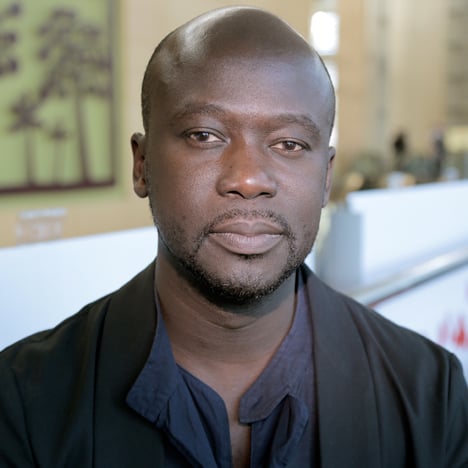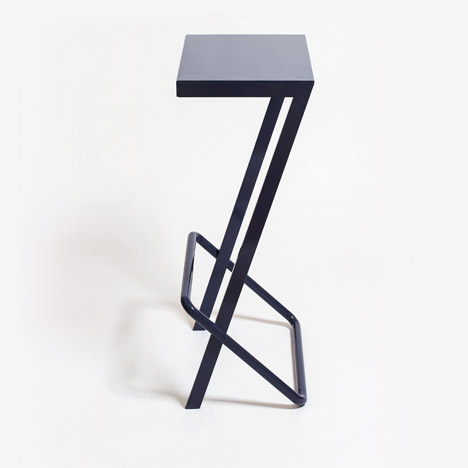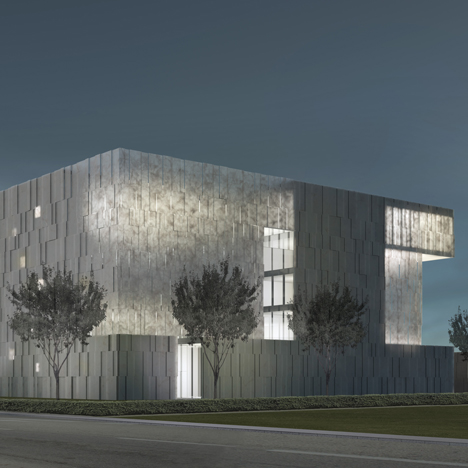"There has to be a social agenda" to my architecture, says David Adjaye
Architect David Adjaye has spoken about the "ethical pride" that drives his studio and explained his approach to designing buildings and furniture in a conversation with Dezeen editor-in-chief Marcus Fairs (+ transcript + slideshow).
"There's an agenda in our work which is that there has to be a democratisation of knowledge, there has to be a social agenda," said Adjaye in the talk, which took place at the Moroso showroom in London last month.
"We always turn down projects," said the architect when asked if this stance meant that the studio rejected lucrative offers. "Sometimes we really regret it! But ... there's not a single project that I'm not proud of. And it's really important to me that I have a kind of ethical pride in my work."

Adjaye spoke at the opening of Art Architecture Design, an exhibition featuring prototypes of his new Double Zero collection for the Italian furniture brand held during Clerkenwell Design Week.
"I wanted to make a chair that was a little bit dumb," he said of the Double Zero, which gets its name from its circular seat and backrest and which was originally created for a building he is designing in Beirut.
"I say that in an ironic way, because I kind of want to make a counter-product to the form or efficiency type of furniture; I wanted to make a piece that almost looks like it just happened."

"People say: is furniture small architecture?" he added "No, furniture is furniture. It's a very different sensibility."
Born in Tanzania in 1966, the British architect made his name with a series of small houses such as the 2002 Dirty House in Shoreditch, London, and collaborations with artists, but has since become a globally recognised figure, and the world's most successful black architect.

Yet despite working on prestigious projects including the Smithsonian Museum of African American History and Culture in Washington DC – and reportedly being in the running to design Barack Obama's presidential library – London-based Adjaye said that he is driven by a different agenda to other leading architects.
Dezeen Book of Interviews: David Adjaye features in our new book, which is on sale now
Of his work in Africa, for example, he said: "There's this dialogue flowing, and that's very important in terms of being able to elevate another generation of architects coming up that can be trained in Africa to be able to have access to material and to be able to express their creativity."
"Well it's Modernism," he replied when asked where his architecture sits in terms of lineage. "I'm interested in the Modern project but the Modern project is something that has to be remade, because actually we've already designed chairs and we've already designed tables, so why do we need to keep doing it?"

Answering his own question, he said: "Actually the value of re-understanding what a table is – why does it have a certain edge, why is it made of a certain material? – continually propels us forward, and helps us to really enjoy the life that we live. And I think that's not to be underestimated."
Below is an edited transcript of the conversation:
Marcus Fairs: Tell us about the Double Zero collection.
David Adjaye: Maybe I should give you a bit of background because I don't see myself as a conventional designer. I'm an architect. My day job is architecture.
Just to talk about Knoll for a second, the only reason I did the Knoll furniture range is because of the work I was doing in Washington. So I was starting to do some very specific work in Washington: museums, libraries, etcetera, and I wanted to make very particular pieces of furniture for those environments.
So I found myself in a position where I was inspired to create certain pieces. And at the beginning I wasn't even sure if I could even call them furniture but rather they were different types of scales of things. Knoll had been trying to speak to me for about a year about doing something, and they came to my studio and saw sketches that I had and said look, let's develop this.
I'm saying that because the work comes out of a specific context. I'm not really a designer who's working within a market. I'm not an inventor who can create things out of my mind – that's very hard for me. Then really with Patrizia [Moroso], I'd been thinking very much that I'd love to work with her and was really waiting for the right context.

Right now we are completing a very large building in Beirut, for an incredibly brave patron who is developing a new art foundation. We've made this 300,000-square-foot building and I realised that again, in this context, I needed to make specific pieces of furniture.
So this series, the Double Zero series, acts as a counterpoint to the architecture. I couldn't find anything else so I decided that I really wanted to make my own, and in a way it's a little critique about furniture right now. I wanted to make something that was incredibly comfortable and to rely on the incredible artisanal skill of Moroso. I know they do many things but one of their great things is upholstery.
And also I wanted to make a chair that was a little bit dumb. I say that in an ironic way, because I kind of want to make a counter-product to the form or efficiency type of furniture; I wanted to make a piece that almost looks like it just happened.

It looks we've picked pieces: we've picked a circle, then another circle, and wrapped it in a ribbon of metal. It's this idea that it has a kind of naivety but actually it's really about the counter-product. That's something that I really wanted to do.
And then it could at the same time be very luxurious, so we could use gold, but also it could be very raw. It could just be base metal and have everything from African patterns to Dutch patterns or Japanese patterns.
So I sent it to Patrizia and she was really intrigued and wanted to develop it. So I spent time in Udine with her incredible team and we very quickly got to these prototypes; the ones you see upstairs.

Marcus Fairs: So you designed the chair specifically for the building in Beirut but now Moroso is putting it into production.
David Adjaye: Yeah exactly. The Beirut project is the context for the form we've made, but really it's now about making a collection for Moroso. That's what it's evolved into.
It's a very large range. It's barstools, dining chairs, lounge chairs and sofas. And there's a very large range of possibilities in terms of finish.
But it's two circles; the Double Zero is the form of the seat and the back.
Marcus Fairs: You came to prominence as an architect who worked with artists and who did a range of stunning small houses in London. But now judging by your Instagram feed, you're on a different continent every three days. You'll be exploring African tombs one day and you'll be in Washington the next. Tell us a little bit about your life these days.
David Adjaye: Nothing's really changed. The reason I'm on Instagram is as much to share with my staff and my friends, but also I really like the idea of being able to use it as a dialogue. To me that's really very central. Even from day one I was always a bit of a peripatetic character. I was always running around, I always wanted to go to places for work but also go to places that inspire me.

I'm always looking and re-looking at things all the time because I really believe that the process of making is a very physical thing, and so you need to physically understand the relationship to things all the time, and the emotional relationship. If you look at the detail one time you perceive it in a way, and then you go back within a certain context and it reads a different way.
So this idea of continuation and going to places that you love, or discovering places that will stimulate you, is for me a very important for my process. And it's not always buildings any more. It can be spaces, it can be environments, it can be words. But yeah, I move around a lot.
Marcus Fairs: Give me an idea of the range of projects you're working on at the moment. There's Beirut, but what are you doing elsewhere?
David Adjaye: We're working on very, very large projects to very, very small projects. So for instance the project with Moroso. We're also working on a range of textiles right now. I'm finishing the museum on the Washington Mall, which will finish at the end of this year but will open in May. We're doing several new things across America.
We're also working on things in London. We're working on housing in Hackney; we're working on some interesting projects that I can't talk about yet! The practice has grown and we are working predominantly in the Middle East, India, Europe, Africa and the US.

Marcus Fairs: Tell us a little bit about your work in Africa.
David Adjaye: For me it's about a democratisation of knowledge, it's about being active in the continent and transferring skills and having the opportunity of doing architecture on any scale. It's really important that techniques that are very commonplace in the West are also transferrable to Africa, and that lessons learned on the ground in Africa inform the practice.
We have masterplans in Africa. We're working on a big children's cancer research and care hospital, the first one on the continent of Africa, in Kigali in Rwanda. That's just about to start.
So there's this dialogue flowing, and that's very important in terms of being able to elevate another generation of architects coming up that can be trained in Africa to be able to have access to material and to be able to express their creativity.
Marcus Fairs: What are you working on in India?
David Adjaye: I think there's a huge emerging market in India. I mean it's still just taking off, but there's a lot of activity. I was brought to a project in Varanasi, to work with a very interesting charity that wants to build an education community centre for silk weavers. Silk weaving was invented not in China but in the north of India, and then that technology was appropriated by the Chinese.
It's died out [in India] because of the way silk production has been industrialised. So the project is to create a centre to re-evaluate the hand-weaving of silk as a real craft, to say this is a very valuable skill which has a 500-year history.
[You could] create an environment where people don't have to move to big cities to find menial jobs. They could be paid really well,: the fashion industry – Yves Saint Laurent and several fashion brands are talking to them – is making Varanasi silk a much higher-priced product to allow communities to really get a better life.
It's really making a change in the community, so the sensibility for the design [of the building] is about allowing designers to come from the west or wherever to work with the craftsmen to create special woven pieces. So I've started to work on that project.

Marcus Fairs: A lot of architects today race around the world looking for the biggest projects they can get. Is it important for you to get involved in projects that are doing some good?
David Adjaye: There's a very clear commitment. There's an agenda in our work which is that there has to be a democratisation of knowledge, there has to be a social agenda.
Architecture has a very unique role in re-scripting the everyday, and it's really important to re-script the everyday because by re-scripting we bring a value to that everyday life. It's something that is really at the core of my practice: to look for that moment where an opportunity creates hybridity; creates a moment where we can re-script the ordinary.
Marcus Fairs: Architecture with a social agenda can be a little patronising; you know, putting a grass roof on a building in Africa… how do you avoid that?
David Adjaye: We would never do that. I'm not being didactic and I'm not trying to simulate anything. It's really just an empathy with the social programme and it's an empathy with the geographic context, but also it's an understanding of the cultural memory of the place.
The buildings always have to be new, because newness is also part of the re-scripting of the everyday. If you don't make something that's new, that idea of the re-scripting is lost. It becomes a simulacrum, it becomes a romantic memory.
So this idea of newness can't be underestimated, it's very important. Newness comes from the translation of all these forces, but it has to make something which is not just to make a spectacle – it's not about creating a virtuoso thing, but it's that combination to make something which is contemporary. For me the work is about what is the contemporary? What is the time we're living in?

Marcus Fairs: Do you see your architecture as part any particular lineage?
David Adjaye: Well it's Modernism. I'm interested in the Modern project but the Modern project is something that has to be remade, because actually we've already designed chairs and we've already designed tables, so why do we need to keep doing it?
Actually the value of re-understanding what a table is – why does it have a certain edge, why is it made of a certain material? – continually propels us forward, and helps us to really enjoy the life that we live. And I think that's not to be underestimated.
Marcus Fairs: You said it's important to democratise knowledge. Do you turn down lucrative projects?
David Adjaye: We always turn down projects. Sometimes we really regret it! But I have an amazing team of people who have been working for me for 15 years and we realise that we're creating a body of work that we're really proud of it. There's not a single project that I'm not proud of. And it's really important to me that I have a kind of ethical pride in my work.

Marcus Fairs: Often when architects design furniture it looks like their architecture shrunk down to furniture scale, or it looks like a detail of one of their buildings.
David Adjaye: I think it's a really terrible trend that somehow a chair has to be a piece of architecture…
Marcus Fairs: …or even the other way round, where people scale up their furniture to the size of architecture.
David Adjaye: I think these are virtuoso tricks that really avoid the subject in hand. I think the subject in hand is to make things that the human body works with, not to show off your virtuoso skills.
So for me, it's a very different thing. People say: is furniture small architecture? No, furniture is furniture. It's a very different sensibility, it comes from a very different route and source, but it comes through architecture. The furniture design pioneers we all know were really architects, but then it exploded into a very specific field.
So for me, to engage with it requires a design sensibility. And I think that the sensibility is not visual, it's not about the mimetic – oh I can see buildings, I can see chairs – that's kind of absurd. It's about the language and the thinking. Do you see a language; do you see an attitude to making?
So for instance the Double Zero, we talk about welding and all these kinds of things that have created these crazy scenarios. But that also happens in the way that I look at materials, and certain juxtapositions that I make. So I don't like to make architecture so mimetic that it becomes like a branding stamp on the forehead, but it should be each time an exploration of the context that draws you to that problem.
Marcus Fairs: You mentioned earlier that the Double Zero range looks a bit ancient Egyptian or little bit Louis XVI. Are those post-rationalisations?
David Adjaye: Totally. After finishing it I stared to just look through things and you go: 'Oh wow, that's a bit like that'. And it's really great for me to see if there are connections. Because nothing is completely original, but the idea is how to make it become something new.